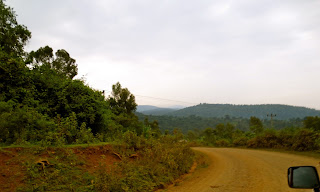 |
| Yabello in the distance |
 |
| Red Soil that reminds me of PEI minus the SUPER dry factor... |
 |
| A termite creation... |
Interviewing someone—asking open ended questions and trying
to make someone feel comfortable enough to share the details of their reality—
in ones native tongue is a challenge in and of itself, working with a
translator added an extra layer of interesting to the process! But as the
morning drew on, I gradually became more comfortable with the process and am
hopeful that the case stories I will write from the material gained will to
justice and adequately represent the work and learning’s of those I
interviewed!
 |
| One of the coop-women asked if we could take a picture! |
Working with the translator was hardly my only encounter
with language immersion. While I am doing my best to pick up the basics of
Amharic (and can now hear many familiar words if I listen closely enough to
conversations around me!) I would be lying if I didn’t say that I had NO IDEA
what the plan was 85% of the time we were away. All of the co-workers I was
with were Ethiopian and while they would do their best to include me in
conversation, I found that people naturally return to their native language,
especially when tired. My friend
and I joke that experiences such as having no idea why the car is pulling over,
or finding out that the reason you never received a menu at lunch was because
you have been ordered a traditional meal already, will only serve to make us
the most easy going people possible! While I still haven’t be able to let go
completely of trying to figure out what’s happening, I try to limit the amount
of questions I ask knowing that my coworkers have thus far only had my best
interest in mind. I am also hopeful that if I keep practicing my Amharic, by
the end of my stay I will know without having to ask that when we randomly pull
over on the side of the highway its because someone wants to buy strawberries!
On another note, Yabello also extended my questioning of the
relationship between Ethiopians and outsiders/ International organizations…
what role do we play? The Borena Zone of Southern Ethiopia, where Yabello is
located, is highly drought prone and as a result is one of the areas with a
high density of AID organizations and NGOs. To paint the picture a little more,
on the 7km drive from the main highway to the town center there are field
offices for; UNFAO, World Vision, Save the Children, USAID and a few other less
known organizations.
 |
| What is a group of camels called? A herd? |
The image which resonates in my mind and really hammered
home this whole idea of a clash of worlds for me was a local man walking down
the side of the road with his two camels who were carrying a What were the stipulations? As always
many, many questions and very few answers was what I was left with. Needless to
say I wont soon forget those two camels.
load (bear in mind
that while on its own this is a new visual for me! it is typical of the area)
but furthermore upon closer examination I noticed that the packs the camels
were carrying were labeled USAID. A flurry of questions instantly flew threw my
mind; how long has this man been receiving AID? What was in the pack? Would be
starve without the assistance? Was it creating dependence?
Much love,
Steph x
As always if you have any comments or questions please feel free to e-mail me at:
steph.milo.mackinnon@gmail.com
 |
 Just a couple of pictures of the Amaro Mountainside on route to Yabello (aprx 150-200km closer to Addis) and some donkeys...
Just a couple of pictures of the Amaro Mountainside on route to Yabello (aprx 150-200km closer to Addis) and some donkeys...





